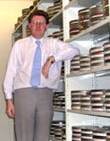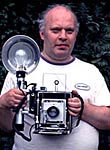|
|
This topic comprises 5 pages: 1 2 3 4 5
|
|
Author
|
Topic: Service Tech Opinions on 70mm Norelco Ad
|
Steve Matz
Jedi Master Film Handler
Posts: 672
From: Billings, Montana, USA
Registered: Sep 2003
|
 posted 05-07-2014 09:45 PM
posted 05-07-2014 09:45 PM




Having a little back and forth exchange on the 16mm Film-talk concerning how many projections a Print can endure before it's not presentable in a Theater Venue any longer. Obviously a number of Factors play into this.(i.e. Competent Projectionist,Equipment,Gate/Pad Pressure,Cleanliness of Transport/and Print,etc.
I'm not sure which Model Norelco this ad would be referring to at the Pantages back then; Possibly a DP70. What I would like to hear from Service Techs up here that have worked on these Norelco's is this a Realistic situation in a general 70mm Booth.
Since Norelco was promoting the sale of this model Projector; I'm sure everything was treated with kid gloves concerning Print Handling, Projector Setup,Maintainence,etc. I IMHO feel that this is an exception to the Rule. I believe the Projector/s supplied to the Pantages for this Showing weren't your off the assembly line Projector that would be going to General Movie Houses.
I think these were probably meticulously hand assembled units that were indexed and blueprinted beyond anything the average Theater would receive. After all our reputation is at stake here also.I haven't heard that much from Projectionists on these machines as to how gentle they are on Film,reliability,etc.
Your Feedback on this Ad would be most informative and appreciated, Thanks!....S.M.

| IP: Logged
|
|
|
|
|
|
Leo Enticknap
Film God

Posts: 7474
From: Loma Linda, CA
Registered: Jul 2000
|
 posted 05-08-2014 12:04 AM
posted 05-08-2014 12:04 AM





That's Ben Wales in the video, isn't it?
When Kodak launched triacetate stock in 1948, they published an SMPTE Journal article, which included the results of research in which they tried to establish the typical life expectancy of a release print in a normal, suburban theater situation. The problem with pre-triacetate safety stocks (diacetate, butyrate and propionate, mainly) was that they were a lot more fragile and expensive than nitrate. These tests were designed to convince studios and theater chains that the new safety stock was as good as nitrate in terms of tensile strength and durability.
My memory is hazy and I don't have a copy of the article immediately to hand (nor a subscription to look at the PDF online), but if I remember correctly, a nitrate print was considered to be capable of withstanding 500-600 projections in what were then considered to be normal projection booth and handling conditions.
But of course a prestige theater in downtown Hollywood is not exactly normal booth and film handling conditions: it's going to have better maintained equipment and probably better trained personnel than a second-run suburban house. It's not really the model of projector that's the biggest determination of print life, but rather the quality of maintenance and film handling in the booth, and how a print is used. A print that plays three bookings a month is probably going to wear out a lot more quickly than one which stays in the same booth, playing four times a day for many months.
| IP: Logged
|
|
|
|
|
|
|
|
|
|
|
|
|
|
|
|
|
|
Steve Matz
Jedi Master Film Handler
Posts: 672
From: Billings, Montana, USA
Registered: Sep 2003
|
 posted 05-08-2014 01:19 PM
posted 05-08-2014 01:19 PM




Very Interesting responses; I guess my skepticism comes from back when all of our indoor theaters in the 50's and 60's were using E7 Simplex's that had been installed as far back as 1941 at the FOX Theater. The 2 projectionists that I knew well enough to know they were Competent Old School Licensed Electricians and could fix anything in their Booths use to tell me on any long run feature that went 12 weeks or longer; they usually asked for a replacement Print after around 7 or 8 weeks.
I know these Projectors were well maintained as I remember being in 2 of these theater's Booths and they were immaculate. The Projectors,Lamphouses,Rectifiers,etc. still looking like they were brand-new.
So if you know your Projectionist is more than competent and keeps a clean projector/equipment,print,etc., is conscious about using minimal Gate/pad pressure short of Flutter,etc. Why would these prints have to be replaced in roughly a 2 month period with an average number of 6 showings a day/night. I know from talking to other old school Projectionists that ran numerous brands of Projectors back then always said Simplex(super,E7,XL straight gate) were rougher on film than other Brands. Even the NORELCO AD said the average life of a 35mm Print was 200 or so Projections. If Simplex's were that rough on Film why were there so many out there and the company surviving while others folded in the 50's. I know going to a curved gate improved the later XL's but I hear more Cons than Pros on them being Rougher on Film than any of the Other Mfgers Equipment...
| IP: Logged
|
|
|
|
|
|
|
|
All times are Central (GMT -6:00)
|
This topic comprises 5 pages: 1 2 3 4 5
|
Powered by Infopop Corporation
UBB.classicTM
6.3.1.2
The Film-Tech Forums are designed for various members related to the cinema industry to express their opinions, viewpoints and testimonials on various products, services and events based upon speculation, personal knowledge and factual information through use, therefore all views represented here allow no liability upon the publishers of this web site and the owners of said views assume no liability for any ill will resulting from these postings. The posts made here are for educational as well as entertainment purposes and as such anyone viewing this portion of the website must accept these views as statements of the author of that opinion
and agrees to release the authors from any and all liability.
|

 Home
Home
 Products
Products
 Store
Store
 Forum
Forum
 Warehouse
Warehouse
 Contact Us
Contact Us




 Printer-friendly view of this topic
Printer-friendly view of this topic




















